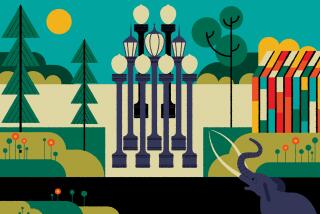Casting LA Culture Net Over a Wider Field
LA Culture Net has been a rather nebulous concept for the past couple of years, floating around in cyberspace while promising to provide a vital link between local cultural organizations and their far-flung audiences. But the collaborative venture spearheaded by the Getty Information Institute has finally gained a much more substantial presence.
The first big step came last fall, when representatives of 28 Southern California groups formed a digital community at a two-day workshop billed as a Web raising. Conceived in the spirit of old-fashioned barn raisings, which assembled rural neighbors to create a community asset, the Web raising was designed to share expertise that’s essential to growth and survival for cultural groups, information institute director Eleanor Fink said.
The Getty got an overwhelming response to the program, so a sequel was planned. Late last month about 70 additional organizations attended a second Web raising. This time participants not only designed home pages and got technical advice on their problems, they witnessed the debut of a new feature of LA Culture Net: “Faces of LA: Histories, Images and Cultural Institutions of Southern California.”
In its inaugural phase, “Faces of LA” links 10 Los Angeles institutions in an online database that provides access to their collections. Current participants are the American Film Institute, the Autry Museum of Western Heritage, the California Museum of Science and Industry, Cal State Northridge’s Special Collections and Archives, the Los Angeles Public Library, the Museum of Tolerance, the Southwest Museum, the UCLA/Fowler Museum of Cultural History, USC’s Libraries Department of Special Collections and the J. Paul Getty Trust.
These organizations, and others to be added, are expected to collaborate in online exhibitions and provide K-12 teachers with educational resource material. Students can use “Faces of LA” as a reference for research projects. As it evolves, the project will beef up the content of LA Culture Net with a wealth of information about the city’s cultural facilities, collections and programs.
“I look to it as a starting point, the beginning of an appreciation for the rich diversity of the community,” Harold Williams, president of the J. Paul Getty Trust, said of LA Culture Net at the recent Web raising. “This can capture the essence of the richness of the cultural heritage of Los Angeles.”
Technology can be a powerful tool if it delivers “high-quality information and engaging content,” Fink said. LA Culture Net is intended to serve both as a community forum and an interactive bank of cultural resources, she said.
“Faces of LA” is found in the “Culture Lab” component of LA Culture Net (https://www.lacn.org). Among other categories of information are: “Tour Bus,” providing an overview of what’s available on the Web site; “People to People,” a chat room; “Tool Room,” an introduction to new systems and products; and “Calendar,” a listing of events.
As is customary in the Getty Trust’s community projects, the information institute is serving as a catalyst to help arts groups create a self-sustaining digital community through LA Culture Net. No one organization can or should support it, Fink said. “We don’t even know what the ideal infrastructure will be, but it will have to involve the private sector and the local government working together.”
While other cities are engaged in efforts to link cultural and educational organizations, LA Culture Net has “a different dynamic” because it is attuned to artists, individuals and cultural diversity, she said.
Both Web raisings were held at Break Away Technologies, a computer learning center in the Crenshaw district, established by Joseph Loeb five years ago in the wake of the riots after the Rodney G. King verdicts.
Looking for a way “to make a difference” in his community, Loeb, a theologian, focused on education. He formed a partnership with Biola University to set up a computer center in his garage, and later moved the operation to a large industrial facility on Jefferson Boulevard. His mission is to “break away from unproductive behavior” and build a bright future for urban youth, he said.
The Getty-sponsored Web raisings have provided new visibility for Break Away Technologies, as a gathering place for representatives of far-flung organizations.
Martin Cox, a photographer who works at Los Angeles Contemporary Exhibitions, an avant-garde arts center that operates on a shoestring budget in Hollywood, paid his first visit last fall. He created a home page for LACE at the first Web raising, then returned in April to help with the second event.
Getting connected electronically has allowed LACE to promote its programs without the cost of printing and mailing, and to expand in a new way. “It’s like gaining a new wing” for experimental exhibitions, Cox said.
But not all the action is in cyberspace, he said. By getting involved with the Web raisings he has met more people from other cultural organizations in a few days than he had in a year at LACE.
*
NEW IN PRINT: Meanwhile, in the field of print communication, a group of artists dubbed Project X has launched a new publication, X-Tra. An introduction in the first issue says contributors will be encouraged to “write substantively and at length” on visual arts and related issues. Edited by Stephen Berens, Ellen Birrell and Jan Tumlir, X-Tra will be published on a flexible schedule in five-issue volumes. Content will include features, reviews, letters, special projects and artists’ pages. Subscriptions cost $15 per volume. Information: Project X, 5150 Dahlia Drive, Los Angeles, CA 90041.
More to Read
The biggest entertainment stories
Get our big stories about Hollywood, film, television, music, arts, culture and more right in your inbox as soon as they publish.
You may occasionally receive promotional content from the Los Angeles Times.










